Five German foods to try this summer
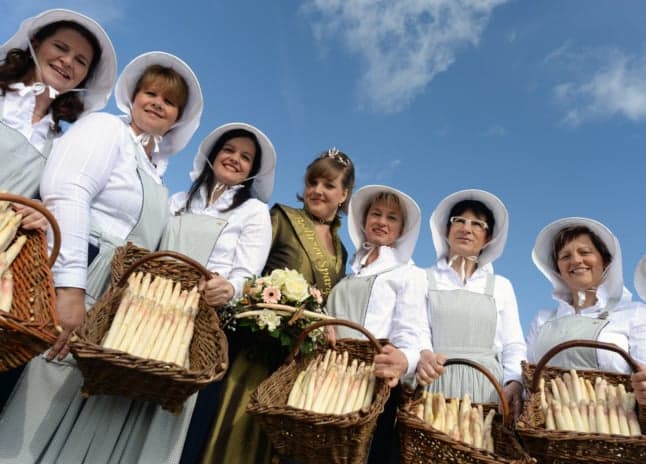
With its hearty pork and potato dishes, you may think that German food is more suited to the winter months - but a taste of these gorgeous summer treats will definitely change your mind.
Each region of Germany has its own summer culinary tradition for the best meals to snack on in the sun. What’s great is that many of them can easily be made vegetarian or vegan.
Why not find some recipes based on the delectable treats below to impress the guests at your next summer party or barbecue?
- Fried herring
Fried, salted herring is a classic northern German dish. It became popular in the Hanseatic League, which grew from a few north German towns in the late 12th century.
The League disintegrated in the late 16th Century, but Bremen, Hamburg and Lübeck remained members until the mid-1800s. Members of the Hanseatic League developed a special cuisine due to their access to rich foreign ingredients from their connections abroad. This made Hanseatic food distinctive and unusual, as it was rare that other regions even in northern Germany would have access to similar ingredients and flavourings.
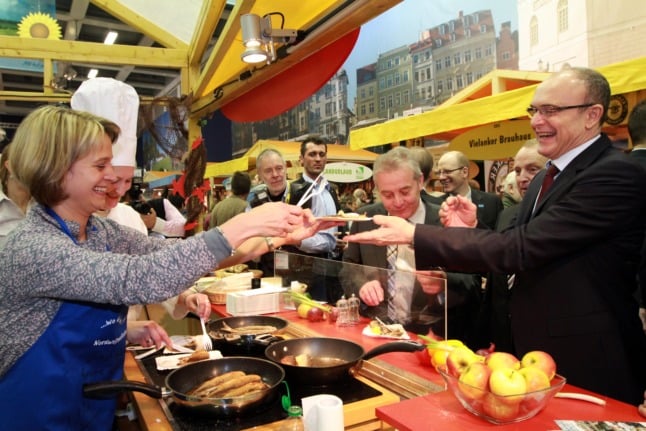
Mecklenburg-Western Pomerania's state premier Erwin Sellering receives a fried herring from District Administrator Birgit Hesse at the International Green Week in Berlin. Fried herring, or Brathering, is a hanseatic speciality. Photo: picture alliance / dpa | Nestor Bachmann
The League traded in herring, so it soon became a staple. Salting the herring helped to preserve it, and the popularity of the food has stuck. Nowadays northern Germans eat Bratheringe - fried and marinated herrings.
Herrings are often served as a salad (with a sour-cream dressing), with cream cheese sauce (Frischkäse-Sauce), marinated with spices or as Berlin-style Rollmops (rolled and stuffed with vegetables and spices). They are often also served with a side of crispy potato slices.
Unfortunately there aren’t many vegan or vegetarian alternatives to this food itself, but beetroots, fried aubergine, apples or gherkins make for good vegan swap-in options in salads.
- White Asparagus
States like Baden-Württemberg and Brandenburg pride themselves on their white asparagus (or Spargel) dishes, as the vegetable stands at the heart of their trade. Some states even rake in big bucks selling ‘asparagus tours’ to tourists where you can explore the asparagus-growing regions and even sample different types of asparagus.
READ ALSO: Only in Germany: McDonald’s begins offering ‘Spargel Burger’
Some cities on the Baden route also offer an annual asparagus festival (Spargelfest) with a whole host of different asparagus-based meals on the menu, alongside fun asparagus-related activities.
It’s such an immensely popular ingredient that around a fifth of Germany’s overall land for vegetable cultivation is reserved for white asparagus.
It is thought that white asparagus was first introduced into Germany via the Roman Empire, but the industry dissolved. It emerged next in the 16th century, but only on the plates of the most wealthy and privileged.

"Spargelino", the mascot of famous Spargel town Beelitz in Brandenburg, walks with an elderly lady through the streets. Photo: Ralf Hirschberger/dpa
The fact that white asparagus used to be reserved for royalty and the court plays no small part in its popularity. It even has two nicknames in Germany which reflect its former pomp and prestige: das Königsgemüse (the royal vegetable) or das Weißgeld (white gold).
READ ALSO: Why Germans go crazy for wild mushrooms in the autumn months
However, with now over 70,000 tonnes of asparagus consumed by Germans per year, the years of scarcity are now being more than made up for.
Asparagus season (or Spargelzeit) usually spans from the middle of April to the end of June, so it is an ideal food for the spring or summer heat and can be converted into a number of diverse and versatile meals.
Spargel can be eaten in soup, salads, tarts, pasta dishes or on its own with a light sauce or vinaigrette. Next time you visit a restaurant during Spargelzeit, you may even see a Spargel pizza on the menu! And if you fancy a tipple, it can also be incorporated into alcoholic drinks such as martinis.
Countless recipes in English or German can be found online if you fancy incorporating this royal food into your summer repertoire. Even better - it’s easy to keep recipes with this ingredient in them vegan or at least vegetarian.
READ ALSO: Spaghetti ice cream to Wobbly Peter: Why we love Germany’s sweet summer snacks
- Cabbage salad
Cabbage salad is a slaw-like, summery salad packed with flavour and nutrients. Red kraut salad is made with shredded red cabbage, red onion, pickled beetroot, vinegar and plum jam, whilst white kraut salad (Weisskrautsalat) is made with white cabbage, vegetable stock, vinegar, sugar and caraway seeds. You can also optionally add bacon - or vegan bacon alternatives if you want to keep it vegetarian or vegan.
The salad is popular far beyond Germany - it is a common side or barbecue dish in America, Poland, Serbia and Hungary. However, Bavarian variations of the salad are favoured throughout Germany.
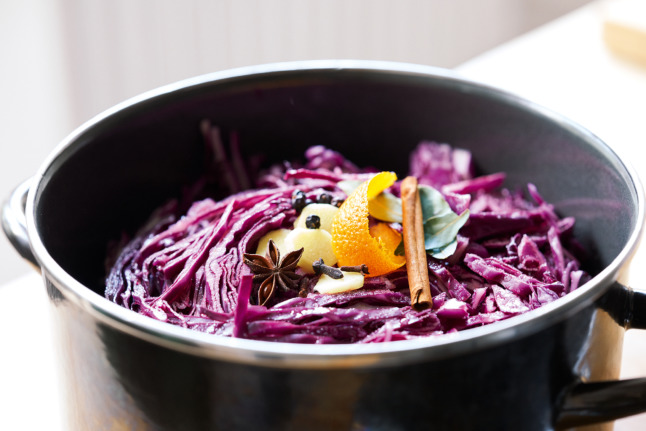
Cabbage salad can be made with either red or white cabbage and served as a delicious side dish at a summer barbecue. Photo: picture alliance/dpa/Gräfe und Unzer Verlag | Oliver Brachat
This simple-to-make, often vegan recipe is a favourite for many Germans in the summer months due to its lightness and versatility. It was also an incredibly widespread and popular food in the GDR, to be found on any raw food buffet.
- Bavarian ‘bee sting’ cream cake
This traditional recipe, called Bienenstich (bee sting cake) in German, has a predictably interesting backstory. According to legend, a feud between the towns of Andernach and Linz escalated into violence when the former was attacked by the latter.
However, the residents of Andernach managed to fend the residents of Linz off by throwing beehives at the attackers, who promptly fled. To celebrate the event, the people of Andernach invented the cake and named it after the event which inspired it.
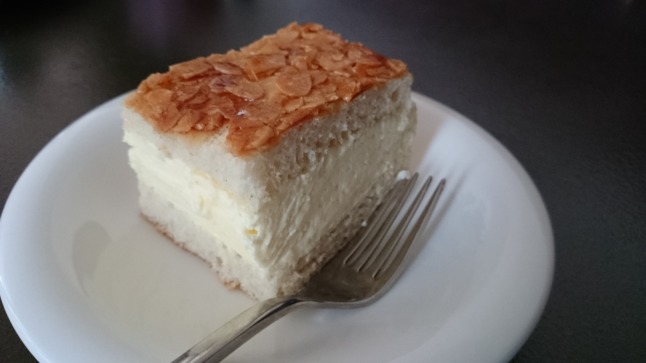
What could be better on a hot summer's day than a light and delicious slice of Bienenstich? Photo: Alice Wiegand / CC-BY-SA 4.0 (via Wikimedia Commons)
The Bienenstich is a rich but not heavy dessert made which combines flaked, caramelised almonds, honey, sweet yeast dough and vanilla custard or cream. The honey is an important component, relating to and recalling the origin tale of the dessert.
The cake takes less than an hour to prepare and is a brilliant addition to any party, barbecue or garden party. If made correctly, it is airy and light to eat - an excellent snack to enjoy in the heat.
READ ALSO: Five German foods that aren’t what you think they are
This dessert is always vegetarian, and there’s a wealth of easy recipes online explaining how to make vegan alternatives which taste just as good as the original.
- Spätzle and spätzle salad
Spätzle dishes originate from Swabia and are eaten at all times of the year, but spätzle salads are a very common side dish at barbecues and other summer events. In fact, around 40,000 tonnes of Spätzle are produced in the German food industry each year - although this is only half as much as annual asparagus consumption, and to my knowledge there’s no Spätzle festival either.
A type of hand-crafted noodle or pasta, spätzle are typically made from a dough which combines egg, flour and salt, although there are easy vegan alternatives to this recipe.
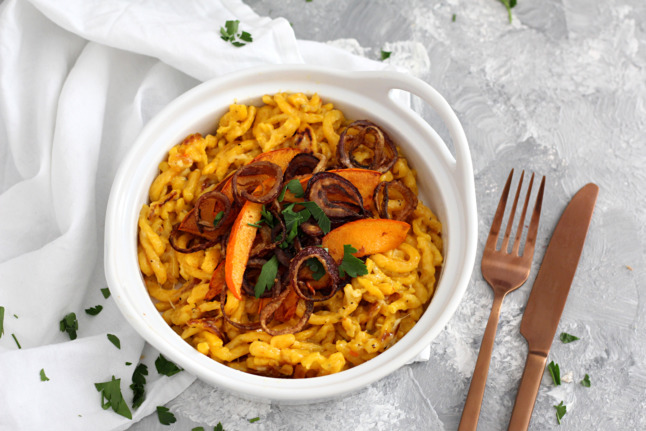
Why not spice up your Spätzle dish with some roasted red onions and pumpkin? Photo: picture alliance/dpa/www.biskuitwerkstatt.de | Mareike Winter
In the summer, Spätzle are mostly served cold with sun-dried tomatoes, courgette, pepper, asparagus, salad leaves and vinaigrette or pesto. This should help to offset a mid-afternoon carb fatigue and leave you feeling light and refreshed.
Making spätzle is also commonly a family activity - some families even have a secret, special recipe for the dish which is handed down to each new generation - so if you’re planning to make this simple and delicious dish from scratch, make sure to enlist the help of your loved ones.
Comments
See Also
Each region of Germany has its own summer culinary tradition for the best meals to snack on in the sun. What’s great is that many of them can easily be made vegetarian or vegan.
Why not find some recipes based on the delectable treats below to impress the guests at your next summer party or barbecue?
- Fried herring
Fried, salted herring is a classic northern German dish. It became popular in the Hanseatic League, which grew from a few north German towns in the late 12th century.
The League disintegrated in the late 16th Century, but Bremen, Hamburg and Lübeck remained members until the mid-1800s. Members of the Hanseatic League developed a special cuisine due to their access to rich foreign ingredients from their connections abroad. This made Hanseatic food distinctive and unusual, as it was rare that other regions even in northern Germany would have access to similar ingredients and flavourings.

Mecklenburg-Western Pomerania's state premier Erwin Sellering receives a fried herring from District Administrator Birgit Hesse at the International Green Week in Berlin. Fried herring, or Brathering, is a hanseatic speciality. Photo: picture alliance / dpa | Nestor Bachmann
The League traded in herring, so it soon became a staple. Salting the herring helped to preserve it, and the popularity of the food has stuck. Nowadays northern Germans eat Bratheringe - fried and marinated herrings.
Herrings are often served as a salad (with a sour-cream dressing), with cream cheese sauce (Frischkäse-Sauce), marinated with spices or as Berlin-style Rollmops (rolled and stuffed with vegetables and spices). They are often also served with a side of crispy potato slices.
Unfortunately there aren’t many vegan or vegetarian alternatives to this food itself, but beetroots, fried aubergine, apples or gherkins make for good vegan swap-in options in salads.
- White Asparagus
States like Baden-Württemberg and Brandenburg pride themselves on their white asparagus (or Spargel) dishes, as the vegetable stands at the heart of their trade. Some states even rake in big bucks selling ‘asparagus tours’ to tourists where you can explore the asparagus-growing regions and even sample different types of asparagus.
READ ALSO: Only in Germany: McDonald’s begins offering ‘Spargel Burger’
Some cities on the Baden route also offer an annual asparagus festival (Spargelfest) with a whole host of different asparagus-based meals on the menu, alongside fun asparagus-related activities.
It’s such an immensely popular ingredient that around a fifth of Germany’s overall land for vegetable cultivation is reserved for white asparagus.
It is thought that white asparagus was first introduced into Germany via the Roman Empire, but the industry dissolved. It emerged next in the 16th century, but only on the plates of the most wealthy and privileged.

"Spargelino", the mascot of famous Spargel town Beelitz in Brandenburg, walks with an elderly lady through the streets. Photo: Ralf Hirschberger/dpa
The fact that white asparagus used to be reserved for royalty and the court plays no small part in its popularity. It even has two nicknames in Germany which reflect its former pomp and prestige: das Königsgemüse (the royal vegetable) or das Weißgeld (white gold).
READ ALSO: Why Germans go crazy for wild mushrooms in the autumn months
However, with now over 70,000 tonnes of asparagus consumed by Germans per year, the years of scarcity are now being more than made up for.
Asparagus season (or Spargelzeit) usually spans from the middle of April to the end of June, so it is an ideal food for the spring or summer heat and can be converted into a number of diverse and versatile meals.
Spargel can be eaten in soup, salads, tarts, pasta dishes or on its own with a light sauce or vinaigrette. Next time you visit a restaurant during Spargelzeit, you may even see a Spargel pizza on the menu! And if you fancy a tipple, it can also be incorporated into alcoholic drinks such as martinis.
Countless recipes in English or German can be found online if you fancy incorporating this royal food into your summer repertoire. Even better - it’s easy to keep recipes with this ingredient in them vegan or at least vegetarian.
READ ALSO: Spaghetti ice cream to Wobbly Peter: Why we love Germany’s sweet summer snacks
- Cabbage salad
Cabbage salad is a slaw-like, summery salad packed with flavour and nutrients. Red kraut salad is made with shredded red cabbage, red onion, pickled beetroot, vinegar and plum jam, whilst white kraut salad (Weisskrautsalat) is made with white cabbage, vegetable stock, vinegar, sugar and caraway seeds. You can also optionally add bacon - or vegan bacon alternatives if you want to keep it vegetarian or vegan.
The salad is popular far beyond Germany - it is a common side or barbecue dish in America, Poland, Serbia and Hungary. However, Bavarian variations of the salad are favoured throughout Germany.

Cabbage salad can be made with either red or white cabbage and served as a delicious side dish at a summer barbecue. Photo: picture alliance/dpa/Gräfe und Unzer Verlag | Oliver Brachat
This simple-to-make, often vegan recipe is a favourite for many Germans in the summer months due to its lightness and versatility. It was also an incredibly widespread and popular food in the GDR, to be found on any raw food buffet.
- Bavarian ‘bee sting’ cream cake
This traditional recipe, called Bienenstich (bee sting cake) in German, has a predictably interesting backstory. According to legend, a feud between the towns of Andernach and Linz escalated into violence when the former was attacked by the latter.
However, the residents of Andernach managed to fend the residents of Linz off by throwing beehives at the attackers, who promptly fled. To celebrate the event, the people of Andernach invented the cake and named it after the event which inspired it.

What could be better on a hot summer's day than a light and delicious slice of Bienenstich? Photo: Alice Wiegand / CC-BY-SA 4.0 (via Wikimedia Commons)
The Bienenstich is a rich but not heavy dessert made which combines flaked, caramelised almonds, honey, sweet yeast dough and vanilla custard or cream. The honey is an important component, relating to and recalling the origin tale of the dessert.
The cake takes less than an hour to prepare and is a brilliant addition to any party, barbecue or garden party. If made correctly, it is airy and light to eat - an excellent snack to enjoy in the heat.
READ ALSO: Five German foods that aren’t what you think they are
This dessert is always vegetarian, and there’s a wealth of easy recipes online explaining how to make vegan alternatives which taste just as good as the original.
- Spätzle and spätzle salad
Spätzle dishes originate from Swabia and are eaten at all times of the year, but spätzle salads are a very common side dish at barbecues and other summer events. In fact, around 40,000 tonnes of Spätzle are produced in the German food industry each year - although this is only half as much as annual asparagus consumption, and to my knowledge there’s no Spätzle festival either.
A type of hand-crafted noodle or pasta, spätzle are typically made from a dough which combines egg, flour and salt, although there are easy vegan alternatives to this recipe.

Why not spice up your Spätzle dish with some roasted red onions and pumpkin? Photo: picture alliance/dpa/www.biskuitwerkstatt.de | Mareike Winter
In the summer, Spätzle are mostly served cold with sun-dried tomatoes, courgette, pepper, asparagus, salad leaves and vinaigrette or pesto. This should help to offset a mid-afternoon carb fatigue and leave you feeling light and refreshed.
Making spätzle is also commonly a family activity - some families even have a secret, special recipe for the dish which is handed down to each new generation - so if you’re planning to make this simple and delicious dish from scratch, make sure to enlist the help of your loved ones.
Join the conversation in our comments section below. Share your own views and experience and if you have a question or suggestion for our journalists then email us at [email protected].
Please keep comments civil, constructive and on topic – and make sure to read our terms of use before getting involved.
Please log in here to leave a comment.